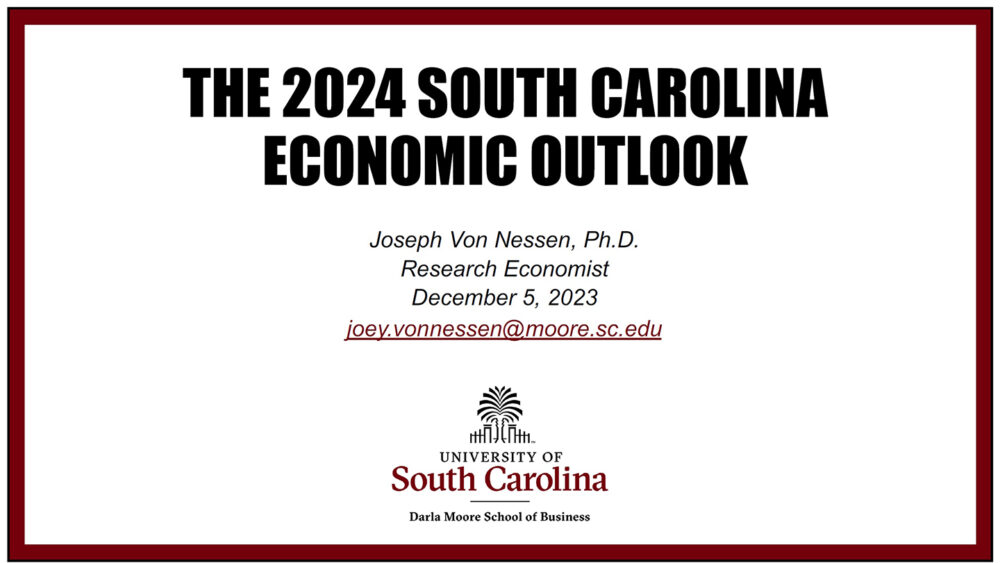Things look good for South Carolina’s economy – now, and in the coming year.
And you know that recession we were supposed to have? It didn’t happen. Not this year, or last year, or the year before. And it seems no more likely to happen in 2024.
Those are some of the happy findings in the 2024 South Carolina economic outlook that Joseph Von Nessen, research economist at the Darla Moore School of Business, presented this month at the school’s annual USC Economic Outlook Conference.
“The EOC is designed to provide actionable information to business and government leaders from around South Carolina each year regarding ‘the state of the state’s economy,’” explains Dr. Von Nessen. “My role is to prepare and present the statewide economic forecast, which I present at the EOC and to various business, civic, and government organizations on a regular basis throughout the year.”
What’s going on now in our state’s economy? We’re “readjusting” after a period of high levels of demand we saw in 2020 and 2021 – demand, that is, for durable goods, such as housing and manufactured items.
Think about what people were spending their money on during the pandemic. Stuck working at home, they were spending a lot on remodeling to make that work better and more pleasant They were also ordering a stupendous number of manufactured goods via Amazon and other internet venues. They were not spending on services, which took a toll on some important South Carolina sectors such as hospitality and travel.
As people emerged from their cocoons in 2022 and 2023, employment in the services sectors bounced back big-time. “Employment growth was 3.7 percent in 2022, and 2.2 percent this year,” said Von Nessen.
That means we’re about done with the readjustment, which makes things look good for 2024. After bouncing back, “Services are continuing to do well, particularly in hospitality and travel,” he said.
We continue to have a “very significant” labor shortage. That is to say, employers at those restaurants and hotels are having trouble finding workers. And “That is likely to be the bottleneck on S.C. growth for the next decade.”
People who think politically have their own favorite explanations of this. People on the right say it’s because workers are lazy – the government paid them not to work during the pandemic, and they lost their work ethic. On the left, you hear that the proletariat has decided not to be exploited any more.
Von Nessen sees it differently. To him, it’s based as much as anything on demographic changes.
“Baby Boomers have been turning 65 since roughly 2010,” he notes. As we’ll all remember, that was as we were coming out of a real recession, and a big one. It was a recession that seriously damaged aging workers’ 401k accounts. Because of that, some kept working for several more years.
“By contrast, they had strong incentives to retire during the pandemic,” and many did so “beginning in 2020 because the stock market was booming, retirement portfolios were up, and the risk of getting COVID at work was high,” he says.
That opened up a lot of jobs that paid better than flipping burgers or waiting tables. So a lot of younger folks leaped at the opportunity to move up.
Responding rationally, employers in the service industries have had to increase wages to be competitive. As a result, for workers, “This is by far the best job market we’ve seen in a generation,” said Von Nessen.
Does that mean all inflation and recession worries are over? No, because it’s always a balancing act. Higher wages can lead to inflation. That leads to higher interest rates. That can cool things down.
Von Nessen is also concerned about a possible emerging trend away from globalization. With the instability we see in the world – the Mideast, Ukraine, and our increasingly tense relationship with China – some manufacturers and other businesses have become less likely to rely on cost-effective global supply chains. This means their goods can become more expensive – which, of course, is inflationary.
How bad that inflation gets, and whether the Federal Reserve can rein it in with interest rates without retarding growth, are the main factors determining the future.
But right now, things look pretty good.



Comments are closed.